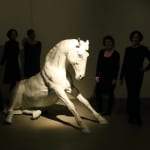Vytautas Viržbickas Lithuanian, b. 1987
Sitting Horse, a part of the installation “How do I tell you a story you already know? -You don't”, 2013
Lipdyta ir atlieta iš poliesterinės dervos, poliuretaninė dvikomponentinė puta, stiklo pluoštas / Molded and casted in polyester resins, two-component polyurethane foam, glass fiber
190 x 130 x 170 cm
Further images
-
(View a larger image of thumbnail 1
)

-
(View a larger image of thumbnail 2
)

-
(View a larger image of thumbnail 3
)

-
(View a larger image of thumbnail 4
)

-
(View a larger image of thumbnail 5
)

-
(View a larger image of thumbnail 6
)

-
(View a larger image of thumbnail 7
)

-
(View a larger image of thumbnail 8
)

-
(View a larger image of thumbnail 9
)

Vytautas Viržbickas's installation 'HOW DO I TELL YOU A STORY YOU ALREADY KNOW? - YOU DON'T' is constructed like a film, with a linear narrative, using the codes and language...
Vytautas Viržbickas's installation "HOW DO I TELL YOU A STORY YOU ALREADY KNOW? - YOU DON'T" is constructed like a film, with a linear narrative, using the codes and language of myth, familiar to everyone.
The interrogative form makes it permissible to analyse the installation. The question “How do I tell you a story you already know?” refers to one of the compositions in the installation which deals with a myth – a story familiar to everyone – while the answer “You don’t.” refers to a second composition in the same installation, the emerged part of the iceberg, as representing partial information about a given fact. For the artist perceives fragments of information as being the only solution faced with the narrative form of a familiar story. He states that knowledge destroys curiosity and the desire to learn. Through this installation, he attempts to analyse the problems associated with “storytelling”.
Vytauto Viržbicko instaliacija mįslingu pavadinimu “-Kaip papasakoti tau žinomą istoriją? -Nepasakok.” sukurta iš įvairių skulptūrų, objektų ir daiktų. Šiose iš pavienių objektų (sukonstruotų, išdrožtų, nulietų, pasiūtų, sudaužytų ir suklijuotų paties menininko rankomis) sudarytose kompozicijose pasakojama mitinė istorija. Trijų dalių (priežastis, pasekmė, išeitis) mitologinio pasakojimo herojai – prasikaltusio šuns poza sėdintis baltas arklys, „pasiduodantis“ (dvi kojas į viršų iškėlęs) stalas, paslaptingą ledkalnį plukdantis „bufetas“ ir kojas miklinantys aukštielninki vabalai, – kvies parodos lankytojus paklaidžioti painiais pasąmonės užkaboriais.
The interrogative form makes it permissible to analyse the installation. The question “How do I tell you a story you already know?” refers to one of the compositions in the installation which deals with a myth – a story familiar to everyone – while the answer “You don’t.” refers to a second composition in the same installation, the emerged part of the iceberg, as representing partial information about a given fact. For the artist perceives fragments of information as being the only solution faced with the narrative form of a familiar story. He states that knowledge destroys curiosity and the desire to learn. Through this installation, he attempts to analyse the problems associated with “storytelling”.
Vytauto Viržbicko instaliacija mįslingu pavadinimu “-Kaip papasakoti tau žinomą istoriją? -Nepasakok.” sukurta iš įvairių skulptūrų, objektų ir daiktų. Šiose iš pavienių objektų (sukonstruotų, išdrožtų, nulietų, pasiūtų, sudaužytų ir suklijuotų paties menininko rankomis) sudarytose kompozicijose pasakojama mitinė istorija. Trijų dalių (priežastis, pasekmė, išeitis) mitologinio pasakojimo herojai – prasikaltusio šuns poza sėdintis baltas arklys, „pasiduodantis“ (dvi kojas į viršų iškėlęs) stalas, paslaptingą ledkalnį plukdantis „bufetas“ ir kojas miklinantys aukštielninki vabalai, – kvies parodos lankytojus paklaidžioti painiais pasąmonės užkaboriais.









